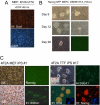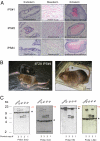Reprogramming of murine and human somatic cells using a single polycistronic vector
- PMID: 19109433
- PMCID: PMC2629226
- DOI: 10.1073/pnas.0811426106
Reprogramming of murine and human somatic cells using a single polycistronic vector
Erratum in
- Proc Natl Acad Sci U S A. 2009 Jul 14;106(28):11818
- Proc Natl Acad Sci U S A. 2009 Mar 31;106(13):5449
Abstract
Directed reprogramming of somatic cells by defined factors provides a novel method for the generation of patient-specific stem cells with the potential to bypass both the practical and ethical concerns associated with somatic cell nuclear transfer (SCNT) and human embryonic stem (hES) cells. Although the generation of induced pluripotent stem (iPS) cells has proven a robust technology in mouse and human, a major impediment to the use of iPS cells for therapeutic purposes has been the viral-based delivery of the reprogramming factors because multiple proviral integrations pose the danger of insertional mutagenesis. Here we report a novel approach to reduce the number of viruses necessary to reprogram somatic cells by delivering reprogramming factors in a single virus using 2A "self-cleaving" peptides, which support efficient polycistronic expression from a single promoter. We find that up to four reprogramming factors (Oct4, Sox2, Klf4, and c-Myc) can be expressed from a single virus to generate iPS cells in both embryonic and adult somatic mouse cells and we show that a single proviral copy is sufficient to generate iPS cells from mouse embryonic fibroblasts. In addition we have generated human induced pluripotent stem (hiPS) cell lines from human keratinocytes, demonstrating that a single polycistronic virus can reprogram human somatic cells.
Conflict of interest statement
Conflict of interest statement: R.J. is an advisor to Stemgent.
Figures




References
-
- Maherali N, et al. Directly reprogrammed fibroblasts show global epigenetic remodeling and widespread tissue contribution. Cell Stem Cell. 2007;1:55–70. - PubMed
-
- Okita K, Ichisaka T, Yamanaka S. Generation of germline-competent induced pluripotent stem cells. Nature. 2007;448:313–317. - PubMed
-
- Park IH, et al. Reprogramming of human somatic cells to pluripotency with defined factors. Nature. 2008;451:141–146. - PubMed
-
- Takahashi K, et al. Induction of pluripotent stem cells from adult human fibroblasts by defined factors. Cell. 2007;131:861–872. - PubMed
Publication types
MeSH terms
Substances
Grants and funding
LinkOut - more resources
Full Text Sources
Other Literature Sources
Molecular Biology Databases
Research Materials

